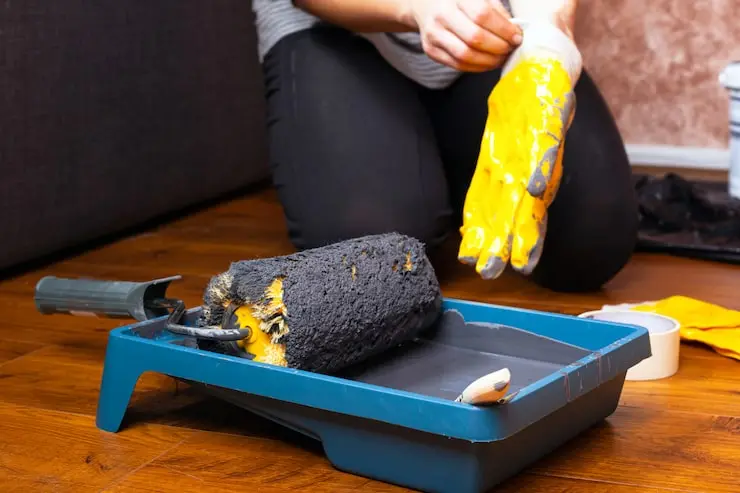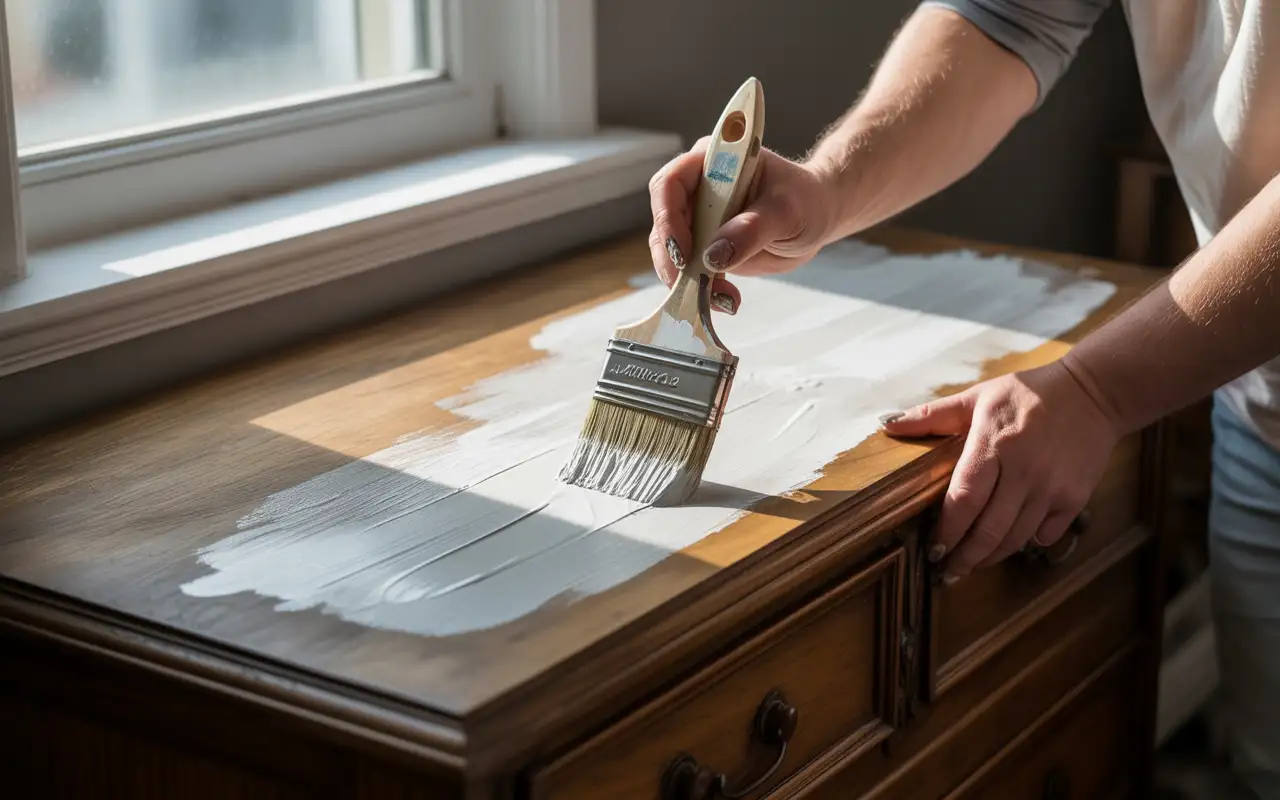The sudden smell of smoke or the sight of sparks dancing in your microwave can be terrifying. A microwave fire damage incident is more common than you might think, leaving homeowners panicked and unsure of what to do next. This comprehensive guide provides clear steps to handle a microwave fire, clean up the aftermath, and most importantly, prevent future incidents, offering you peace of mind and safety.
Why Did Your Microwave Catch Fire in the First Place?
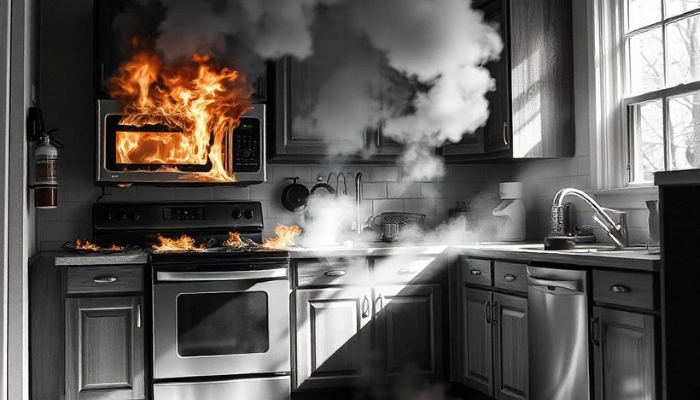
Knowing why your microwave caught on fire is the first step to preventing it from happening again. Most microwave fires start due to simple mistakes or a lack of awareness about how these powerful appliances work.
- Metal Objects: This is a classic cause of microwave on fire situations. Metals like aluminum foil, cutlery, or even decorative trim on plates can’t be used in a microwave. They reflect the microwaves, causing electrical arcs and intense heat, leading to microwave sparks inside.
- Overheating Food or Empty Microwave: Heating food for too long, especially high-fat or sugary items, can cause it to ignite. Running an empty microwave is also dangerous; without food to absorb the energy, the magnetron can overheat, leading to significant damage and potential fire.
- Faulty Wiring or Electrical Issues: Sometimes, the problem isn’t with what you put inside. Internal wiring issues or a failing magnetron can cause a fire in the microwave. If your microwave frequently trips a breaker or makes unusual noises, it might have an electrical fault.
- Improper Use of Containers: Not all containers are microwave safe. Plastics not labeled specifically for microwave use can melt or release harmful chemicals. Even paper products like paper towels or brown paper bags can catch fire if overheated, especially if they are close to the heating element or contain grease.
- Food Splatter or Grease Buildup: Old food particles and grease accumulating on the interior walls or ceiling can ignite during operation. This is why regular cleaning is vital.
- Manufacturer Defects: While rare, a defect from the factory can sometimes cause a microwave to catch fire.
Understanding these common culprits empowers you to avoid them, keeping your kitchen safer.
User Error or Appliance Fault? Here’s How to Tell
If your microwave caught on fire from something you placed inside (like foil), that’s user error. If it sparked on its own or blew up while empty, it’s likely a hardware fault.
Did You Know? Microwaving nothing at all can damage the magnetron and might start a fire.
How to Safely Put Out a Microwave Fire (Step-by-Step)

When a microwave blows up or catches fire, quick and correct action is crucial. Panicking can make the situation worse. Here’s what to do immediately:
- Don’t Open the Door! This is the most critical step. Opening the door introduces oxygen, which will feed the flames and make the fire much larger. Keep the door closed.
- Unplug the Microwave: If it’s safe to do so without getting too close to the flames, unplug the appliance. This cuts off the power supply, which can help the fire die down.
- Monitor the Fire: Often, a small fire inside the microwave will burn itself out once the power is cut off and oxygen is limited. Watch it closely from a safe distance.
- Use a Fire Extinguisher (If Necessary & Safe): If the fire doesn’t go out or starts to spread, and you have a Class K (for kitchen fires) or an ABC extinguisher, you can use it, but only if you feel safe and confident. Aim at the base of the flames.
- Evacuate if Fire Escalates: If the fire grows, fills the kitchen with smoke, or you feel unsafe, evacuate everyone from your home immediately and call emergency services (e.g., 911).
- Ventilate the Area: Once the fire is completely out and it’s safe to do so, open windows and doors to air out the kitchen and remove smoke.
Remember, your safety comes first. Do not hesitate to call for professional help if the situation feels overwhelming.
What NOT to Do
- Don’t open the door too soon.
- Don’t throw water.
- Don’t ignore burnt smells after it could mean hidden damage.
How to Clean Your Microwave After a Fire: 6 Essential Steps
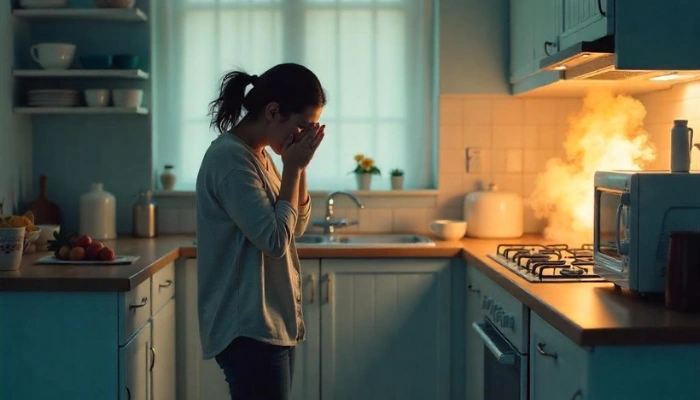
After a microwave fire, dealing with the burnt aftermath can be daunting. Proper cleaning is essential, not just for aesthetics but to eliminate odors and residues.
- Ensure Safety First: Before you begin, open windows and doors to ventilate the area. Wear gloves and a mask to protect yourself from smoke residue and strong odors.
- Remove Debris: Carefully scoop out any charred food, melted plastic, or other burnt items. Dispose of them in a sealed bag to contain the smell.
- Wipe Down Interior Surfaces: Mix a solution of equal parts white vinegar and water, or create a paste with baking soda and a little water. Apply the solution or paste to the inside walls, ceiling, and floor. Let it sit for a few minutes to break down the grime. Then, wipe thoroughly with a clean cloth.
- Clean the Turntable and Rollers: Remove the turntable and the roller ring. Wash them in warm, soapy water or run them through your dishwasher.
- Address the Exterior: Don’t forget the outside! Wipe down the microwave’s exterior, including the handle and buttons, with an all-purpose cleaner.
- Thorough Drying: After cleaning, leave the microwave door ajar to allow it to air dry completely. This prevents mold and helps dissipate lingering odors.
If you see wiring damage, leave it to the pros.
San Diego Home Remodeling offers full fire cleanup and restoration help. Don’t risk a second fire getting it checked by professionals.
How to Eliminate the Burnt Smell From Your Microwave
The burnt smell won’t just vanish. Try these simple tricks:
- Baking soda: Place an open box inside overnight.
- Steam clean with lemon: Microwave a bowl of water with lemon slices for 3 minutes.
- Activated charcoal: Set a charcoal bag inside for 24 hours.
Avoid using bleach or strong chemicals; they can damage parts and leave harmful fumes.
These tips also help if your microwave sparks inside or after any small fire.
Microwave Fire Stats Every Homeowner Should Know
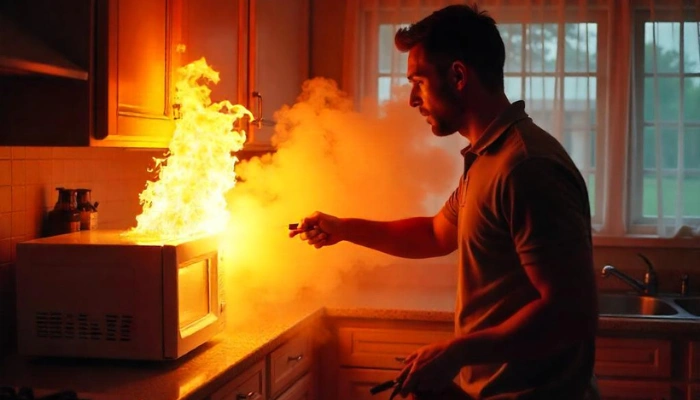
Here’s what the numbers say:
- Over 7,000 home fires are started by microwaves each year (NFPA).
- Most are caused by improper use, not faulty appliances.
- Average repair costs after a microwave fire range from $300–$800.
- Full replacements or remodels can cost much more.
Takeaway: Most microwave fires are preventable. Awareness = safety.
Microwave Safety Tips to Prevent Fires
Preventing a microwave caught on fire incident is far easier than dealing with the aftermath. Incorporate these habits into your daily routine:
- Read the Manual: Always read your microwave’s instruction manual. It contains specific guidelines for safe operation and types of containers to use.
- Use Microwave-Safe Containers ONLY: Look for labels like “microwave safe” on dishes and containers. Never use metal, aluminum foil, or containers with metallic trim. Avoid re-using plastic takeout containers unless specifically marked as microwave safe, as some plastics can warp or release chemicals.
- Never Heat Metal: This cannot be stressed enough. Metal creates sparks and can quickly ignite a fire. Even seemingly innocent items like twist ties can cause microwave sparks inside.
- Don’t Overcook: Start with shorter cooking times and add more if needed. Overcooking, especially high-fat foods like popcorn or foods with sugary glazes, is a common cause of overheated food incidents that catches fire.
- Clean Regularly: A clean microwave is a safer microwave. Wipe up spills and food splatters immediately. Accumulated grease and food particles can ignite.
- Supervise Cooking: Especially when heating foods prone to burning, like popcorn or baked goods, stay near the microwave and watch it closely.
- Check for Damage: Regularly inspect the microwave for signs of damage, such as a worn power cord, a door that doesn’t seal properly, or unusual noises. Any of these could indicate a safety hazard.
- Avoid Running Empty: Never turn on an empty microwave. Without food to absorb the energy, the magnetron can be damaged and potentially overheat, leading to a microwave blew up scenario.
These simple steps can significantly reduce your risk of microwave fire damage.
Still Smelling Smoke or Seeing Damage? When to Repair vs. Replace
After a small fire in your microwave, you might wonder if it’s salvageable. This decision is crucial for your home’s safety.
When to Replace (Strong Recommendation):
It’s almost always safer to replace your microwave if:
- Visible Internal Damage: You see charring, warped metal, melted plastic, or any visible structural damage to the interior cavity.
- Smoke Lingering Despite Cleaning: If the burnt smell or visible smoke persists after thorough cleaning and airing, toxic residues might be deeply embedded.
- Electrical Issues: The microwave trips breakers, sparks when plugged in, or shows any signs of electrical malfunction.
- Age of the Microwave: Older microwaves might be less efficient and more prone to electrical issues.
- Cost of Repair vs. New Unit: Often, the cost of professional inspection and repair outweighs the cost of a new, safer appliance.
When Repair Might Be an Option (with Caution):
In very rare cases, if the fire was extremely minor and contained, with no structural damage or lingering smell, a certified appliance technician might be able to inspect and clear it for use. However, this is uncommon, and the default should always be replaced.
Safety Warning: Never risk using a damaged appliance. Even a seemingly minor microwave fire damage can compromise internal components, posing a serious electrical and fire hazard in the future. Prioritize safety over saving a few dollars.
Choose San Diego Home Remodeling for Fire Damage Restoration
While you might only see damage to your microwave, a microwave fire damage incident can cause hidden issues. Smoke and soot can spread rapidly, impacting walls, ceilings, upholstery, and even air ducts. Lingering smoke odors can penetrate porous materials, creating long-term health risks and discomfort. This is where professional help becomes indispensable.
When a microwave fire extends beyond the appliance, specialized Fire Damage Restoration Services in San Diego are essential. At San Diego Home Remodeling, we understand the unique challenges of fire and smoke damage. With over 5 years of experience, our certified professionals are equipped to handle every aspect of restoration, ensuring your home is safe, clean, and healthy again.
Why choose us?
- Expertise You Can Trust: Our team comprises experienced professionals trained in advanced smoke, soot, and odor removal techniques. We assess both visible and hidden damage.
- Comprehensive Services: We don’t just clean up; we restore. From structural repairs to air quality improvement and complete odor elimination, we address all aspects of fire damage, ensuring your entire home is safe.
- Advanced Technology: We utilize state-of-the-art equipment for thorough cleaning, air scrubbing, and deodorization, tackling even the toughest smoke residues.
- Customer-Centric Approach: We prioritize clear communication, transparent processes, and unwavering support, guiding you through every step of the restoration.
- Local Focus: As a San Diego-based company, we understand local building codes and insurance processes, providing tailored, efficient service.
- Seamless Process: From initial assessment to working with your insurance, we make the restoration process as stress-free as possible.
Don’t let microwave fire damage compromise your home’s safety and value. The hidden aftermath of smoke and soot can have lasting effects. For expert Fire Damage Restoration Services in San Diego, contact San Diego Home Remodeling today for a free consultation. Act now to protect your property and ensure a healthy living environment.
Final Thoughts
Dealing with microwave fire damage can be unsettling, but with the right knowledge, you can manage the immediate aftermath and prevent future incidents. From understanding common causes to implementing proactive safety tips and knowing when to call for professional restoration, you are now equipped to keep your home and family safe. Prioritize safety, always.
Need other updates after smoke damage? We also offer top-rated Painting Services in San Diego to refresh your space post-restoration.
FAQs
Is it safe to use a microwave after a fire?
Generally, no, unless a certified appliance technician has thoroughly inspected it and deemed it safe. Visible damage, lingering smoke, or electrical issues mean it must be replaced for safety.
Is it safe to sleep in the house after a microwave fire?
It depends on the fire’s extent and smoke. For small, contained fires with immediate ventilation, it might be. However, if there’s significant smoke, structural damage, or lingering odors, it’s safer to evacuate and consult with fire department or restoration professionals before returning due to risks like carbon monoxide.
What happens if a fire occurs inside the microwave?
A fire inside a microwave can damage the appliance itself (magnetron, interior lining), release toxic smoke and soot, and potentially spread to surrounding cabinets or the kitchen if the door is opened or the fire is not contained.
What to do after a small microwave fire?
Keep the door closed. Unplug the microwave if safe. Allow it to cool and self-extinguish. Ventilate the area thoroughly. Do not use the microwave again until professionally inspected or replaced. Clean the microwave and surrounding area meticulously.
How to get burning smell out of microwave?
Clean the microwave thoroughly with a mixture of water and white vinegar or baking soda. Place a bowl of activated charcoal, coffee grounds, or baking soda inside the microwave overnight. Boil a bowl of lemon water or vinegar in the microwave for a few minutes to create steam, then let it sit. Ensure good ventilation in the kitchen.


